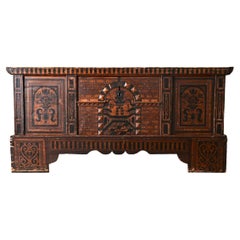Trunks and Luggage
1980s Modern Vintage Trunks and Luggage
Canvas
1980s Modern Vintage Trunks and Luggage
Leather
20th Century French Other Trunks and Luggage
Gold Plate
1980s Modern Vintage Trunks and Luggage
Canvas
19th Century Swedish Other Antique Trunks and Luggage
Iron
19th Century Dutch Other Antique Trunks and Luggage
Iron
19th Century Dutch Other Antique Trunks and Luggage
Oak
19th Century Dutch Other Antique Trunks and Luggage
Oak
19th Century French Other Antique Trunks and Luggage
Oak
1980s Modern Vintage Trunks and Luggage
Canvas
1970s French Other Vintage Trunks and Luggage
Leather, Canvas
1980s French Other Vintage Trunks and Luggage
Leather, Cane
Early 2000s French Modern Trunks and Luggage
Canvas
15th Century and Earlier French Other Antique Trunks and Luggage
Brass
1910s French Other Vintage Trunks and Luggage
Brass
Early 2000s French Other Trunks and Luggage
Leather, Canvas
1910s French Other Vintage Trunks and Luggage
Brass
1910s French Other Vintage Trunks and Luggage
Brass
1910s French Other Vintage Trunks and Luggage
Leather, Canvas, Wood
1920s French Other Vintage Trunks and Luggage
Brass
1910s French Other Vintage Trunks and Luggage
Brass
Early 1900s French Other Antique Trunks and Luggage
Brass
Early 1900s French Other Antique Trunks and Luggage
Brass
1910s French Other Vintage Trunks and Luggage
Leather, Canvas, Wood
Early 1900s French Other Antique Trunks and Luggage
Brass
1930s French Other Vintage Trunks and Luggage
Brass
20th Century French Other Trunks and Luggage
Brass
1920s British Other Vintage Trunks and Luggage
Brass
1880s British Other Antique Trunks and Luggage
Brass
20th Century British Other Trunks and Luggage
Silk
20th Century French Other Trunks and Luggage
Brass
20th Century French Other Trunks and Luggage
Brass
20th Century French Other Trunks and Luggage
Brass
20th Century French Other Trunks and Luggage
Brass
20th Century French Other Trunks and Luggage
Brass
20th Century French Other Trunks and Luggage
Brass
20th Century French Other Trunks and Luggage
Brass
20th Century French Other Trunks and Luggage
Brass
20th Century French Other Trunks and Luggage
Brass
20th Century French Other Trunks and Luggage
Brass
20th Century French Other Trunks and Luggage
Brass
19th Century French Other Antique Trunks and Luggage
Steel
18th Century Italian Other Antique Trunks and Luggage
Wood
2010s American Other Trunks and Luggage
Leather
20th Century French Modern Trunks and Luggage
Leather
20th Century French Modern Trunks and Luggage
Metal, Chrome
1950s Chinese Other Vintage Trunks and Luggage
Wood
20th Century French Modern Trunks and Luggage
Chrome
20th Century French Modern Trunks and Luggage
Leather
1980s French Modern Vintage Trunks and Luggage
Leather
20th Century French Modern Trunks and Luggage
Leather, Mirror
20th Century Italian Modern Trunks and Luggage
Silver
21st Century and Contemporary British Modern Trunks and Luggage
Brass
20th Century French Modern Trunks and Luggage
Leather
20th Century French Modern Trunks and Luggage
Leather
1980s French Modern Vintage Trunks and Luggage
Leather
1960s French Modern Vintage Trunks and Luggage
Leather
Late 19th Century Other Antique Trunks and Luggage
Steel
Antique and Vintage Trunks and Luggage
Add a charming piece of travel history to your space. Antique and vintage trunks and luggage can make a statement as decorative accents and practical furnishings in nearly every room of your home.
There have been many types of trunks and luggage over the years, with availability of these wares broadening as train travel expanded during the 19th century. Antique steamer trunks — named for their use on steamships — mostly date from around 1880 to 1920. These pieces of luggage fit a steamship’s luggage size regulations and essentially doubled as wardrobes, ensuring that a traveler’s evening dresses and suits were kept wrinkle-free on a journey from city to city.
In 1858, French luxury brand Louis Vuitton introduced the world to the now-iconic Louis Vuitton trunks. During this early period of railroad travel, Louis Vuitton trunks solved common travel problems. Instead of the traditional round shape, these handcrafted rectangular trunks stored better on trains. To discourage burglars, the French craftsman and his son, Georges, also eventually patented a revolutionary sophisticated lock for the trunks. The famous LV monogram was first used in 1896 as part of an initiative by Georges to prevent counterfeiting of his coveted travel trunks.
Even if no longer used for travel, the vintage luggage is a popular item among collectors for its historical value and charm. At home, an old wood trunk is a durable storage solution as much as it is a versatile surface. It’s a coffee table in the living room of your farmhouse-style home or rustic loft apartment and a nightstand or blanket chest at the foot of your bed in your bedroom.
From Victorian trunks to Art Deco traveling jewelry cases, journey through history today with an extensive collection of antique trunk suitcases and vintage luggage on 1stDibs.





